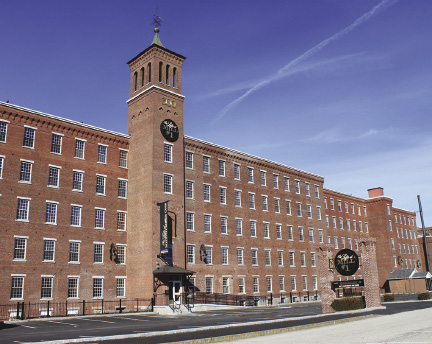Manchester mayor Ted Gatsas cut the ribbon at Brady Sullivan Properties' grand opening of their latest renovation project in the Manchester Mill Yard at 300 Bedford St. March 14.
Continuing their history of award-winning mill yard renovations in N.H., Mass. and R.I., Brady Sullivan has reintroduced the 110-unit 300 Bedford St. mill as "The Lofts at Mill Number One" after a lengthy and detailed renovation effort. The Manchester-based real estate developer was careful to retain many original interior and exterior elements such as the large oversized windows, heavy timber framing, wood plank flooring and exposed brick and beams, while adding finishes such as granite countertops, stainless steel appliances, designer carpet selections, in-unit washer/dryers, and central air, as well as an onsite fitness center, media room, outdoor courtyard and indoor basketball court.
"We are so happy to be bringing new life to yet another one of Manchester's treasured mill properties," said Brady Sullivan owner/partner, Arthur Sullivan. "With every one of these historic renovations that we do in Manchester, there is always a sense of great pride in our city and its heritage, and all of the incredible teamwork that goes into such a big project like this. We couldn't have done it without the help of all the talented contractors and crew who worked in painstaking detail to maintain the historical integrity of the property, while transforming it into elegant living spaces that truly embody the modern Manchester lifestyle."
Constructed by the Amoskeag Manufacturing Co. in 1840-1841, 300 Bedford St. incorporates the first two mills (New Mills No. 1 and 2) built by the company for their own use on the east side of the Merrimack River. In 1859-1860 the space between the previously detached Mill No. 1 and 2 was filled by the construction of Mill No. 6 which gave the company additional spindle, loom and card capacity for the manufacture of fancy goods. The three joined buildings with attached picker houses and a later (c.1890) finishing room addition on the west side, played an integral role in the company's manufacturing process until Amoskeag ceased operations in 1936. Beginning in 1941, the building was used for more than thirty years for shoe manufacturing.
Brady Sullivan Properties purchased the historic property in December of 2011 from 300 Bedford Street Building Owner, LLC and L-A 300 Bedford Street Land Owner, LLC. The $12 million project began immediately following the purchase.
Tags:
Brady Sullivan completes $12 million renovation at 300 Bedford Street
April 04, 2013 - Northern New England
.png)







